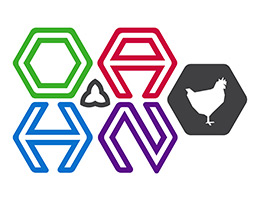Ontario Animal Health Network (OAHN)
Poultry Expert Network
Quarterly Veterinarian Report
Ensuring optimal test results from your diagnostic laboratory:
Garbage in … garbage out
Dr. Emily Martin, Animal Health Laboratory, University of Guelph.
When practicing clinical veterinary medicine, I am sure it sometimes feels like the diagnostic laboratory is like a black box: feed samples in, magic happens, reports are generated, and results are used for case management. However, it cannot be stressed enough that the better the samples fed into the black box, the more useful the information will be for both you and your client. Filling out forms and organizing samples can be a bit intimidating, but by stocking standard sampling supplies, and developing a sampling routine, your case submission can be well organized to flow through the lab in a timely manner.
Understanding how a diagnostic lab is organized aids in understanding why duplicate samples are sometimes requested. I like to envision the AHL as being organized like a spoked wheel (Figure 1): Specimen Reception is the central hub where all the samples arrive for accessioning and each lab is a separate spoke in the wheel. If liver is required for bacteriology and virology, then the most efficient movement of samples would involve 2 separate bags of liver to be sent to each lab. If a sample needs to be split or shared between labs, this creates delays. If there are any issues with sample organization, this can also cause delays in getting your samples to the required labs in a timely manner.
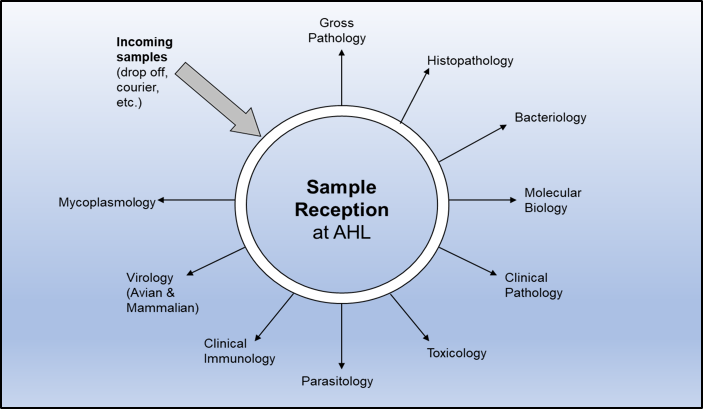
Issues identified by Specimen Reception as causing delays include:
- Case history: Needs to include species, age, commodity, and differential diagnoses.
- These key pieces of information are used by the labs to appropriately set up samples for the correct tests on the correct media.
- Sample packaging:
- Collect separate tissues (or swabs) for different lab areas.
- DO NOT put organ tissues and intestinal tissues in the same bag! (Contamination!)
- Use good sampling equipment – your samples are valuable!
- Whirlpak bags (sterile) better than Zip Lock.
- Use Whirlpaks correctly – fold tabs onto bag so they do not unravel
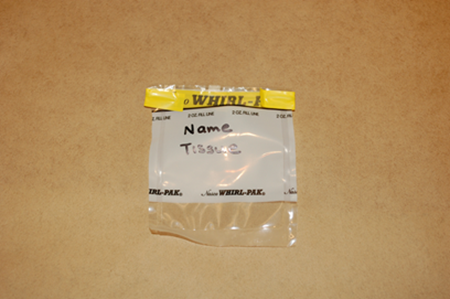
-
-
- Use jars made for Formalin (Specimen jars ≠ Formalin jars, Leakage = Biological hazard)
-
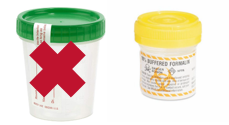
-
-
- Viral Transport Media:

- VTM can contain antibiotics (e.g. gentamicin and amphotericin B) that are effective against Mycoplasma. Do not use dry swabs, Mycoplasmas need to be kept moist.
- Wooden handled swabs are not acceptable (virucidal preservative used in the wood).
- Commercial VTM products (stabilizers and antibiotics to protect samples during shipping).
- Other options if no VTM available:
- Sterile swabs in sterile saline.
- Use leakproof, impact-resistant containers.
- Can agitate swabs in VTM (or saline), then dispose of swab.
- Gel swabs: Use for bacteriology and mycoplasmology
- Viral Transport Media:
-
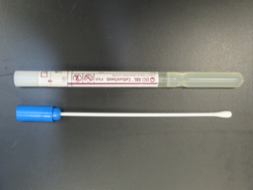
-
-
-
- Formalin: 1 part tissue to 10 parts formalin
-
-
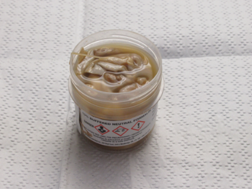
-
-
-
-
- Whole organs are not needed. Portion of organs preferred (e.g. ventricles of heart, 1-2 cm intestine, half of 1 bird lung).
- Sample 3-5 birds (do postmortem, pick birds to sample, consistently sample tissues from each bird so a pattern of disease can be established).
- Collect fresh tissues and formalin fixed tissues from the same birds so results can be correlated.
-
-
-
- If unsure of testing approach, collect and hold samples frozen at your clinic so they are available for further testing if needed.
- Thoroughly label every sample (tissues smoosh in transit and can be hard to identify, the source of a swab is significant for interpretation of final results)
- Packaging important! Need to meet standards for Transportation of Dangerous Goods, Type 1B packaging: watertight inner packaging surrounded by absorbent material, watertight secondary inner packaging, and sturdy outer packaging (corrugated cardboard).
A bit of time invested in organizing your samples will ensure timely movement of your samples through the lab, avoid the need for laboratory staff to contact you to clarify the submission, and result in a better diagnostic outcome.
Poultry Veterinarian Survey Highlights – Q3 2023 (Jun-Aug)
Broilers
ILT
AHL: One case diagnosed as a Niagara-like field strain (cluster CAGG).
Practitioners: Reported as stable to slightly decreased this quarter.
Early systemic bacterial infection (<14 d old) – ESBI
AHL: The number of cases were decreased from the previous 3 quarters. All cases had at least Escherichia coli isolated either in pure culture or in combination with Enterococcus cecorum, or E. cecorum and Staphylococcus aureus.
Practitioners: Practitioners indicated stable to decreased cases this quarter. Bacteria isolated included E. coli, E. cecorum, S. aureus, and Clostridium perfringens.
Other causes of early mortality (>14 d old)
AHL: Other causes of early mortality were mycotic pneumonia.
Practitioners: There were stable to decreased cases reported this quarter. Starve outs were mentioned as a cause.
Late systemic bacterial infection (>14 d old) – LSBI
AHL: The number of cases were decreased from the previous 3 quarters. E. coli and E. cecorum were each isolated either in pure culture or in combination. In 1 case E. coli was isolated with Enterococcus faecalis.
Practitioners: Practitioners were split in reporting either increased or decreased numbers of infections comparable with last quarter. E. coli and E. cecorum were identified as bacterial agents responsible for LSBI. Practitioners reported that 0-50% of E. coli isolates have been resistant to Trimethoprim sulfa (TMS).
Lameness – viral
AHL: The confirmed reovirus pathology cases were less than the previous 3 quarters (but similar to the number of cases for Q4 2022 and Q1 2023). There were also fewer PCRs run and no isolates were sequenced. One reovirus suspicious case was identified on histopathology.
Practitioners: Cases were reported as stable to decreased by practitioners.
Lameness – bacterial
AHL: Cases were decreased compared to the previous 3 quarters. These cases were primarily diagnosed on histology.
Practitioners: Practitioner responses were evenly split between decreased, stable and increased this quarter. The primary bacteria identified were listed as E. coli and E. cecorum.
Lameness – developmental
AHL: Cases were decreased from the previous 3 quarters. The primary diagnosis identified was tibial dyschondroplasia.
Practitioners: The practitioner responses were primarily decreased to stable with 1 practitioner indicating increased cases.
Lameness – nutritional
AHL: There were no nutritional causes of lameness identified in this quarter.
Practitioners: Responders reported stable to decreased incidence of nutritional lameness.
Ascites
AHL: No cases of ascites were diagnosed this quarter.
Practitioners: Reported as stable to decreased this quarter.
Coccidiosis and necrotic enteritis
AHL: Cases of coccidiosis were stable compared to the last 3 quarters. Cases of necrotic enteritis were similar to the previous quarter. The majority of coccidiosis cases were identified in the small intestine but cecal coccidiosis was also identified.
Practitioners: Equal numbers of practitioners responded that cases of both coccidiosis and necrotic enteritis were decreased, stable, or increased this quarter. High mortality (~20%) due to coccidiosis was experienced in 1 organic flock (the flock was vaccinated for coccidia).
Inclusion body hepatitis (IBH)
AHL: Histologic cases decreased slightly to levels similar to Q4 2022 and Q1 2023. Viral isolations were exactly the same as the previous quarter. Fowl Adenovirus PCR identified the most common species was FAdVE. PCR testing identified increased numbers of FAdVAC and FAdVE/FAdVD in this quarter compared to previous quarters. As in previous quarters, on sequencing the primary strain identified was FAdV08b (i.e., FAdV08b_AHL_16-049095_ON and FAdV08b_AHL_18-057921_ON). However, increased numbers of FAdV11_USA_1047 were also identified this quarter.
Practitioners: Equal numbers of practitioners reported decreased or stable cases of IBH and only 1 practitioner reported IBH cases as being increased.
Infectious bursal disease
AHL: The number of pathology cases as well as virus isolations were decreased to similar levels as Q4 2022. On sequencing there were predominantly field strains identified: USA PA105-2014 field strain, USA Del-E field strain, and USA 66-Indiana-2014. The BC 15-062782 field strain identified in Q1 2023 was identified again in this quarter.
Practitioners: Reported as stable to increased cases this quarter. Only 1 practitioner responded with cases being decreased this quarter.
Infectious bronchitis (IBV)
AHL: The number of pathology cases as well as virus isolations were decreased to similar levels as Q4 2022. Pathology cases were suspicious based on histopathology while virus isolations identified IBV_DMV_ON_21-017385.
Practitioners: IBV detection was reported stable to increased this quarter. Only 1 practitioner responded with cases being decreased this quarter.
Spiking mortality
AHL: One case of spiking mortality was diagnosed based on histopathology.
Practitioners: Reported as stable to slightly decreased for this quarter.
Salmonella
Practitioners: Salmonella isolations were reported as primarily stable this quarter with 1 practitioner reporting as increased. The most common serotypes identified were S. Livingstone, or Type C.
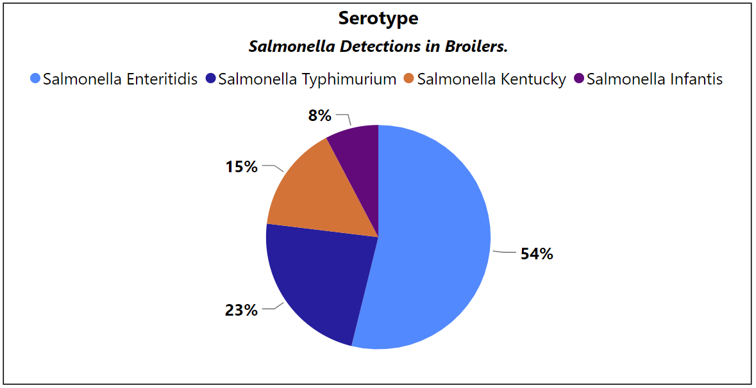
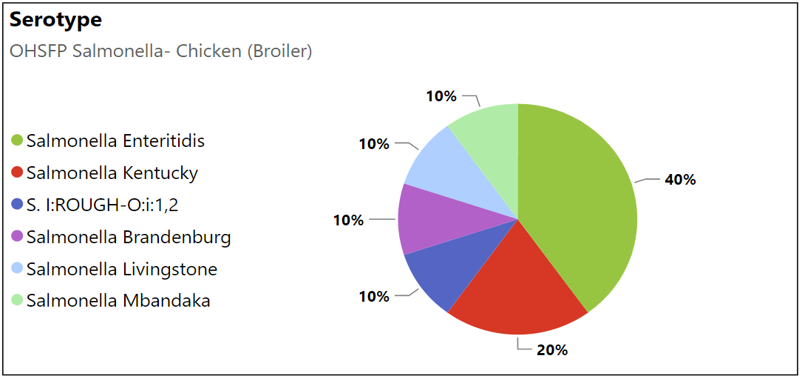
Histomoniasis (blackhead)
AHL: No cases of histomoniasis diagnosed this quarter.
Practitioners: All practitioners reported as stable.
Runting and Stunting Syndrome (RSS)
AHL: Confirmed and suspect cases of RSS (diagnosed on histology) were decreased from the previous 2 quarters to levels similar to Q4 2022.
Practitioners: RSS caused by astrovirus were reported as stable to slightly decreased.
Other diagnostic findings
AHL: Other diagnoses made at the AHL included bacterial and/or fungal pneumonia, urate nephrosis, necrotizing typhlitis, and heat stress.
Practitioners: The only other cause of early mortality listed was proventricular dilation syndrome.
Condemnation issues
AHL: No condemnation cases in this quarter.
Practitioners: Conditions were reported as primarily stable with only one practitioner reporting decreased cases. Lesions in subcutaneous tissues was listed as a cause of increased condemnations.
Slaughter provincial plants: The top 5 condemnation conditions for June 2023 were ascites > airsacculitis/CRD, cellulitis > hepatitis, peritonitis, and for July 2023 were ascites, cellulitis > airsacculitis/CRD, hepatitis, peritonitis. Data from August 2023 are not yet available. The top 5 condemnation conditions for June 2022 to July 2023 were ascites > cellulitis > airsacculitis/CRD > hepatitis > peritonitis.
Slaughter federal plants: For June, Federally Inspected Chicken Plant Data (AAFC). Ontario: ~22 million slaughtered (1.87 kg avg). Top 3 disposition categories: Sub-cutaneous conditions > abdominal edema > liver conditions.
Broiler-Breeders
Fowl cholera
AHL: Occasionally isolated from lameness cases from vaccinated flocks.
Practitioners: Reported as stable this quarter. Described as lameness and joint infection following vaccination. Usually identified in males.
Early bacterial infection (<14 d old)
AHL: The number of cases were increased from the previous 3 quarters. Cases had E. coli isolated in pure culture or in combination with E. cecorum, or P. aeruginosa. One case had E. coli, P. aeruginosa, and C. perfringens isolated.
Practitioners: The majority of practitioners reported as stable but 1 reported as decreased and 1 reported as increased. The bacteria isolated include E. coli, E. cecorum, and S. aureus.
Other causes of early mortality (<14 d old)
AHL: The number of cases were increased this quarter compared to the previous 3 quarters. Cases included dehydration, tenosynovitis (E. coli +/- E. cecorum), and liver hemorrhage.
Practitioners: Reported as stable to slightly decreased this quarter.
Prelay morbidity/mortality (<20 weeks)
AHL: The case numbers were decreased to a level similar to Q4 2022. Cases of septicemia had E. coli and E. cecorum isolated. Other diagnoses included tenosynovitis (S. aureus), intussusception, dehydration, and emaciation.
Practitioners: The majority of practitioners reported as stable with one 1 reporting increased cases.
Lameness – bacterial
AHL: The case numbers were similar to the previous quarter. Cases were primarily pure culture of S. aureus. One other case identified E. coli while the remainder were diagnosed on histopathology.
Practitioners: Stable to slightly decreased. Bacteria identified included E. coli, E. cecorum and Staphylococcus aureus.
Lameness – viral, developmental and nutritional
AHL: There were multiple cases of pododermatitis diagnosed primarily on histopathology. One case had both E. coli and E. cecorum isolated. Cases of reovirus were suspicious on histopathology (1 case) and 3 PCRs were positive for reovirus. On sequencing of 2 of these isolates, 1 was vaccine related (USA s1133 vaccine) and one was SK_R12.
Practitioners: All reported as stable by practitioners.
In-lay bacterial septicemia
AHL: Cases were increased this quarter to higher levels than the last 3 quarters. Isolations included E. coli or S. aureus alone or in combination. For the remaining cases E. coli and E. cecorum were isolated together as well as in combination with S. aureus, C. perfringens, or C. perfingens and G. anatis.
Practitioners: Septicemia was reported as stable by the majority of practitioners with 1 reporting decreased and 1 reporting increased cases. E. coli is listed as the main bacteria isolated.
Other causes of in-lay mortality
AHL: Diagnoses included: fungal pneumonia, oophoritis (E. coli, S. aureus), salpingitis (E. coli/E. cecorum, G. anatis), and lymphoid neoplasia.
IBV – decreased production/abnormal eggs
AHL: No cases of IBV related to decreased egg production or abnormal eggs diagnosed this quarter.
Practitioners: Reported as primarily stable to slightly increased this quarter. DMV and California strains listed as being identified.
IBV – sudden spike in mortality
AHL: The case numbers were similar to the previous quarter but decreased from Q1 2023. The strains identified included IBV_Mass-H120 vaccine, IBV_Mass-MA5 vaccine, IBV_DMV_ON_15-077145, IBV_CA_1734_04_ON_12-025379, and CU82792.
Practitioners: Reported as primarily stable to slightly increased this quarter. DMV strains listed as being identified. Discussions revealed that flocks identified as having both a mild feed issue and DMV strains of IBV appeared to be more severely affected in terms of production, with production stalling in the mid to high 70% range while coming into production.
Disease related hatchability issues
Practitioners: Reported as stable to slightly increased for this quarter.
Mycoplasmosis
AHL: No cases of mycoplasmosis diagnosed this quarter.
Practitioners: Stable to slightly decreased this quarter.
Necrotic enteritis
AHL: One case diagnosed this quarter having both C. perfringens and E. cecorum isolated.
Practitioners: The number of necrotic enteritis cases were reported as primarily stable with 1 practitioner reporting decreased cases and 1 practitioner reporting increased cases.
Coccidiosis
AHL: Cases slightly increased from the previous quarter. Coccidia identified in the small intestines, ceca, or both. One case had lesions of E. necatrix.
Practitioners: Generally stable number of cases reported. One practitioner reported decreased cases and 1 reported increased cases compared to last quarter.
Fowl pox and ILT
AHL: No cases of fowl pox or ILT diagnosed this quarter.
Practitioners: Reported stable for this quarter.
Salmonellosis (clinical)/Salmonella isolation
Practitioners: Stable with a variety of Salmonella isolates identified including: S. Infantis, S. Seftenberg, S. Brandenburg, S. Livingstone, and S. Kiambu. The autogenous vaccine contains S. Infantis that is being isolated in barns, not from fluff samples.
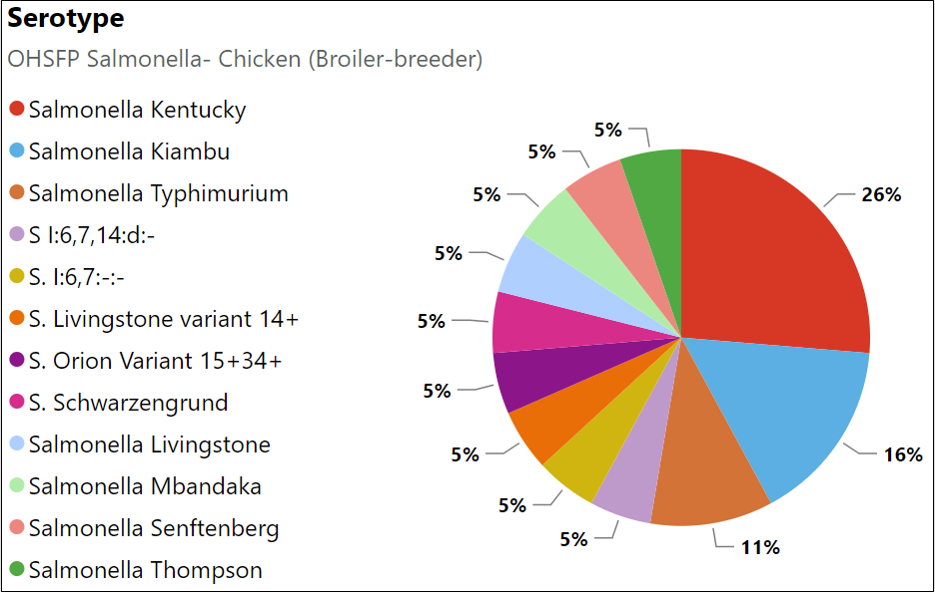
Aggression and cannibalism
AHL: No cases of aggression and cannibalism diagnosed this quarter.
Practitioners: Cases were reported as stable.
Multi-drug resistant E. coli (resistant to >3 drugs)
Practitioners: Reported as stable to slightly decreased.
Histomoniasis (blackhead)
AHL: Two cases of histomoniasis diagnosed in this quarter.
Practitioners: Stable to slightly increased cases reported. One flock reported as a repeat case despite cleaning and disinfection.
White Chick Syndrome
AHL reported 1 case and practitioners reported 2 cases diagnosed this quarter. Practitioners reporting that this is still occasionally identified.
Other
AHL: Other diagnoses this quarter included bacterial pneumonia (isolated E. cecorum and G. anatis with either E. coli or S. aureus), intestinal parasitism (Ascarids/Heterakis, Capillaria), proventricular glandular dilation, bone fracture, heart failure, and myositis.
Practitioners: Three responders mentioned other cases as being stable.
Layers
Practitioners reported stable to slightly decreased cases in most disease categories for the past 3 months.
Osteoporosis/Leg issues
AHL: No cases identified for either condition this quarter.
Practitioners: Stable condition.
Bacterial peritonitis/salpingitis
AHL: No cases diagnosed this quarter.
Practitioners: Stable to slightly decreased cases.
Early systemic bacterial infection (<14 old) – ESBI
AHL: No cases diagnosed this quarter.
Practitioners: Reported as stable to slightly increased cases.
Other causes of early mortality (>14 d old)
AHL: No cases diagnosed this quarter.
Practitioners: Reported as stable for this quarter.
Prelay mortality (<20 weeks)
AHL: The number of cases was slightly decreased from the previous 2 quarters. Diagnoses included E. coli septicemia, rickets, and encephalitis.
In-lay mortality
AHL: There was a slight increase in cases compared to the previous 3 quarters. Diagnoses included: septicemia (E. coli, E. cecorum, S. aureus), dehydration/urate nephrosis, and salpingitis.
Focal duodenal necrosis (FDN)
AHL: No cases diagnosed this quarter (diagnosis made on histopathology).
Practitioners: Most practitioners reported as stable but 1 reported as decreased and 1 reported as increased. This condition is usually diagnosed more in the summer months. When there is a history of insufficient egg size due to heat then practitioners look for this condition.
IBV- production drop/abnormal eggs and respiratory issues
AHL: Slightly decreased cases from the previous quarter and equivalent cases identified on virology compared to last quarter. On sequencing the strains identified included: IBV_DMV_ON_15-077145, CU82792 AHL 07-21349, IBV_Mass-MA5 vaccine, and IBV_Conn vaccine. There was 1 case of increased mortality associated with a DMV strain.
Practitioners: Stable cases reported for both presentations of IBV. There was 1 case of persistent right oviduct associated with high mortality.
Salmonellosis (clinical) / Salmonella isolation
Practitioners: Reported as stable. When flocks are identified with S. Enteritidis then the flocks are destroyed. The primary sources of infection are considered to be rodents (mice, rats) or darkling beetles. The OHSFP identified S. Kiambu and S. Thompson as the primary serotypes identified in layer chickens.
ILT and Mycoplasma
AHL: No cases identified this quarter.
Practitioners: Stable for both conditions.
Coccidiosis and necrotic enteritis
AHL: No cases of either condition were diagnosed this quarter.
Practitioners: Reported stable to slightly increased for both conditions.
Aggression, cannibalism and hysteria
Practitioners: All reported as stable this quarter.
Multi-drug resistant E. coli (resistant to >3 drugs)
Practitioners: Reported as stable.
Histomoniasis (blackhead)
AHL: No cases diagnosed this quarter.
Practitioners: Stable for this quarter.
Other
AHL: Other diagnoses included: conjunctivitis/necrotizing dermatitis (S. aureus, E. coli, E. cecorum, Bacteroides fragilis), necrotizing dermatitis/abscessation (S. aureus, E. coli), and adenocarcinoma.
Practitioners: Reported as stable. One practitioner mentioned Enterococcus faecalis infection resulting in amyloid arthritis and runting/stunting in brown pullets (described in Europe but not in North America).
NOTE: Greater than 50% of birds are now in extensive housing vs conventional cages. This is ahead of the 2036 target. The Egg Farmers of Canada (EFC) are aiming to replace conventional cages ahead of the target date.
Turkeys
Compared with last quarter, disease conditions in turkey flocks were considered stable.
Fowl cholera and Erysipelas
AHL: No cases diagnosed this quarter.
Practitioners: Both conditions were reported as stable.
Early systemic bacterial infection (<14 day old) – ESBI
AHL: Increased cases compared to last quarter. Cases of septicemia had Streptococcus gallolyticus isolated alone or in combination with E. coli and S. aureus. Other isolations included E. coli alone or in combination with P. aeruginosa. A case of yolk sacculitis had S. Newport, E. coli, and S. aureus isolated. S. gallolyticus has been identified in all 3 quarters of 2023. S. gallolyticus affects poults at 14-15 days of age, infections tend to repeat, and infections occur in RWA flocks.
Practitioners: Reported as stable to increased cases. Practitioners listed Streptococcus gallolyticus, E. coli, and Salmonella as bacteria isolated from this age group.
Other causes of early mortality (<14 d old)
AHL: No other causes of early mortality identified this quarter.
Practitioners: Reported as stable to slightly increased cases for this quarter. Aspergillosis was listed as a cause.
Late systemic bacterial infection (>14 d old) – LSBI
AHL: The number of pathology cases were significantly decreased from last quarter but decreasing to levels similar to Q4 2022 and Q1 2023. E. coli was isolated in all cases either in pure culture or in combination with E. cecorum, or Streptococcus gallolyticus.
Practitioners: Stable to slightly decreased cases reported. Practitioners listed bacteria including: E. coli, P. aeruginosa, C. perfringens, S. aureus, Salmonella (group B), and Streptococcus gallolyticus.
ORT
AHL: No cases diagnosed this quarter.
Practitioners: The majority of practitioners reported this condition as stable. However, 1 reported decreased cases and 1 reported increased cases.
Mycotic respiratory disease
AHL: One case of Aspergillosis diagnosed this quarter.
Practitioners: Stable to slightly decreased.
Other respiratory diseases
AHL: Cases of bacterial pneumonia were decreased from the previous quarter, matching levels observed in Q4 2022 and Q1 2023. One case of pneumonia had E. coli, S. aureus, and S. Newport isolated. One other case was diagnosed as bacterial airsacculitis.
Practitioners: Cases reported as being stable compared to the previous quarter.
Coccidiosis, Histomoniasis and Multi-drug resistant E. coli (resistant to >3 drugs)
AHL: Cases of small intestinal coccidiosis were stable compared to the previous 3 quarters. One case of Histomoniasis diagnosed (last diagnosis of this condition in turkeys was in Q4 2022).
Practitioners: All conditions were reported as stable to slightly increased. Proximity of turkey farms to chicken broiler breeder farms is considered a risk factor for Histomoniasis in turkeys.
Necrotic enteritis and enteritis
AHL: One case of necrotic enteritis (without coccidial organisms) diagnosed this quarter. NE previously diagnosed in Q4 2022 and Q1 2023.
Practitioners: Necrotic enteritis was listed as being primarily stable. However, 1 reported decreased and 1 reported increased cases. Cases of enteritis were reported as stable to slightly increased.
Mycoplasma (species)
Practitioners: Cases reported as being stable.
Reovirus tenosynovitis
AHL: The number of pathology cases increased in Q2 2022 and a similar number of cases were identified in this quarter (Q3). Twelve cases were diagnosed on histopathology. Eight cases had positive PCR results. One case had neurologic signs suspected of being due to a reovirus infection.
Practitioners: Reported as stable to slightly increased cases this quarter.
Round heart
Practitioners: Stable condition this quarter.
Salmonellosis (clinical)/Salmonella isolation
AHL: No salmonella cases identified in this quarter.
Practitioners: Reported as stable to slightly increased. Listed serotypes included: S. Typhimurium, S. Sentfenberg, and S. Bredeney.
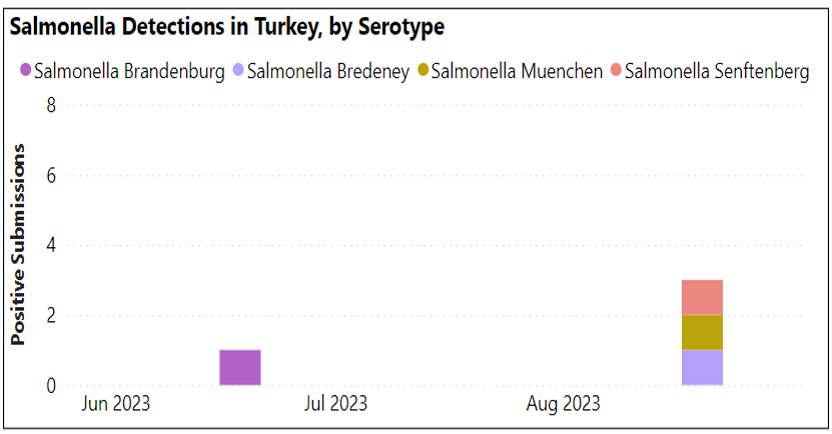
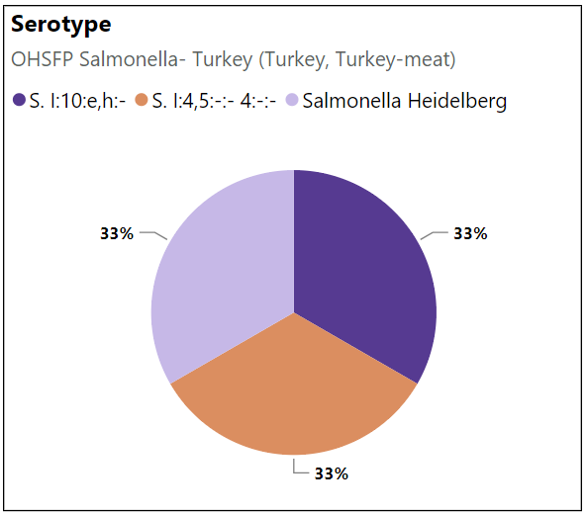
Aggression and cannibalism
Practitioners: Reported as stable compared to last quarter.
Other
AHL: Other diagnoses included tibial dyscondroplasia, tenosynovitis (histology), intrahepatic hemorrhage, heart failure, atherosclerosis, hepatic lipidosis, urate nephrosis/visceral urates, chondrodystrophy, and dermatitis/cellulitis.
Practitioners: Reported as stable for this quarter. Reovirus encephalitis was listed as another diagnosis in turkeys.
Provincial slaughter plants: The top 5 condemnation conditions for June 2023 were cellulitis > airsacculitis/CRD > peritonitis > hepatitis > ascites, and for July 2023 were abscess > cellulitis, neoplasm > airsacculitis/CRD > deep pectoral myopathy. Data from August 2023 are not yet available. The top 5 condemnation conditions for June 2022 – July 2023 were abscess > airsacculitis/CRD > cellulitis > hepatitis > peritonitis.
Federal slaughter plants: For June, Federally Inspected Turkey Plant Data (AAFC). Ontario: ~935.5 thousand slaughtered (7.84 kg average weight).
Top 3 disposition categories: subcutaneous conditions > emaciation > ‘other’.
Rural/Backyard/Non-Quota Flocks
Chickens
AHL: Diagnoses at AHL included intestinal parasitism (coccidiosis including SI, cecal, E. necatrix; ascarids, heterakis, tapeworm), Marek’s disease, ILT (1 Niagara-like field strain CAGG cluster, 1 CEO/TCO vaccine like strain TCAA cluster), emaciation, dehydration, bacterial sinusitis, Mycoplasma gallisepticum, necrotic enteritis, splenomegaly, and IBV (PCR).
Practitioners:
Decreased: Gastrointestinal impaction.
Stable to decreased: Other (coccidiosis/necrotic enteritis).
Stable: Ectoparasitism (lice, mites, scaly leg mites), other neoplasia, trauma, vent trauma, pododermatitis, peritonitis/salpingitis, bacterial septicemia, pneumonia/ airsacculitis, fatty liver haemorrhagic syndrome (FLHS), urate nephrosis/visceral urates/articular urate deposits, ascites, ILT, Histomoniasis, Erysipelas, toxin ingestion, and mycoplasma.
Stable to increased: Intestinal parasitism, and Marek’s disease.
Turkeys
AHL: One case of gastrointestinal impaction.
Practitioners: No cases reported in turkeys for this quarter.
Gamebird
AHL: No cases reported in gamebirds this quarter.
Practitioners: No cases reported in gamebirds this quarter.
Waterfowl
AHL: Three cases in waterfowl (ducks) this quarter. Diagnoses included: rickets, septicemia (Streptococcus gallolyticus), and Leucocytozoonosis with septicemia.
Practitioners: All conditions reported as generally stable. Other diagnoses were listed as slightly increased where the diagnosis was trauma due to predation.
Poultry research from Ontario and beyond
- Poultry Industry Council: Biosecurity & Disease (resource page) https://www.poultryindustrycouncil.ca/resources/biosecurity-and-disease
- Small Flock Ontario https://smallflockontario.ca/
- CDC Technical Report: Highly Pathogenic Avian Influenza A (H5N1) Viruses https://www.cdc.gov/flu/avianflu/spotlights/2022-2023/h5n1-technical-report_september.htm
- Hyperimmune egg yolk antibodies developed against Clostridium perfringens antigens protect against necrotic enteritis https://www.sciencedirect.com/science/article/pii/S0032579123003607
- Effect of glycosaminoglycans on the structure and composition of articular cartilage and bone of broilers https://www.sciencedirect.com/science/article/pii/S0032579123004352
Events and News
Poultry Industry Council events: https://www.poultryindustrycouncil.ca/events
Poultry Health Research Network information, events, and lectures can be accessed on the PHRN website: https://phrn.net/ or on the PHRN YouTube channel: https://www.youtube.com/user/PoultryHRN
Thank You!
We thank the following poultry veterinarians who completed the veterinary survey:
Dr. Elizabeth Black, Dr. Joanne Dias, Dr. Fernando Salgado-Bierman, Dr. Shahbaz Haq, Dr. Elana Huong, Dr. Anastasia Novy, Dr. Mike Petrik, Dr. Erin Preiss, Dr. Joanne Rafuse, Dr. Stephanie Rheaburgen, Dr. Kathleen Sary, Dr. Ben Schlegel, Dr. Chanelle Taylor, Dr. Brenna Tuer, Dr. Alex Weisz, Dr. Jessalyn Walkey and Small Flock Veterinarians.
